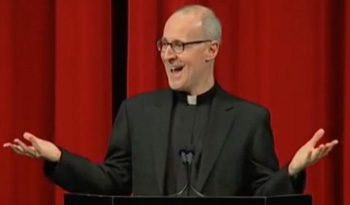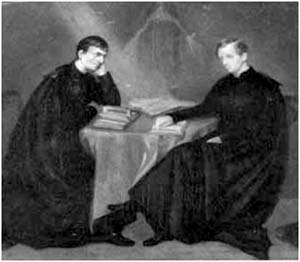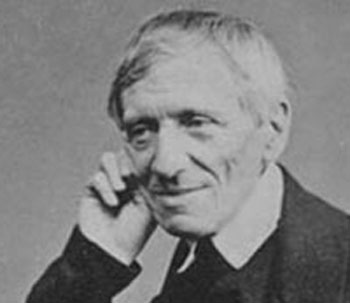Traditionalist Issues
 |
 |
 |
 |
 |
 |
 |
‘It’s Not Unreasonable to Think Newman Might Have Been Homosexual’
The day before the canonization of Card. John Henry Newman last October 2019, American Jesuit Fr. James Martin
brought the question of Newman’s alleged homosexuality to the forefront again, writing: “It isn't a slur to suggest that Newman may have been gay.”
 Indeed, questions about Newman’s sexuality have been the subject of heavy media attention for more than 20 years. It began in 2008, when Pope Benedict XVI ordered the exhumation and re-burial of Newman’s remains as part of the “first step towards his beatification.” This soon became the source of a heated controversy, with “gay rights” activist Peter Tatchell making a
public statement of criticism against the “homophobic” Vatican.
Indeed, questions about Newman’s sexuality have been the subject of heavy media attention for more than 20 years. It began in 2008, when Pope Benedict XVI ordered the exhumation and re-burial of Newman’s remains as part of the “first step towards his beatification.” This soon became the source of a heated controversy, with “gay rights” activist Peter Tatchell making a
public statement of criticism against the “homophobic” Vatican.
Why was Newman’s exhumation such a big problem? Before his death, Newman wrote that he wished “with all his heart” to be buried in the same grave as Fr. Ambrose St. John, his younger disciple and longtime companion, declaring this to be his “last, imperative will.” The two lived together for 32 years “as husband and wife,” and just as Newman requested, he was buried in St. John’s grave after his death.
Tatchell accused the Vatican of defying Newman’s last will in order to cover up his homosexuality: “The Vatican's decision to move Cardinal Newman's body from its resting place ... violates Newman's repeated wish to be buried for eternity with his life-long partner Ambrose St John. They have been together for more than 32 years and the Vatican wants to disturb that peace to cover up the fact that Cardinal Newman loved a man.” (ibid)
 Card. Murphy O’Connor, Archbishop of Westminster, and at that time the highest Catholic authority in England, immediately sent his spokesman Austen Ivereigh to carry out damage-control. Ivereigh did not deny Newman’s alleged homosexuality, but seems to have added more fuel to the fire, saying that his “deep love” for St. John was indisputable, and that in the Victorian era “these very intense, passionate, but totally celibate relationships in Oxford and among the Anglo-Catholic community were very common."
Card. Murphy O’Connor, Archbishop of Westminster, and at that time the highest Catholic authority in England, immediately sent his spokesman Austen Ivereigh to carry out damage-control. Ivereigh did not deny Newman’s alleged homosexuality, but seems to have added more fuel to the fire, saying that his “deep love” for St. John was indisputable, and that in the Victorian era “these very intense, passionate, but totally celibate relationships in Oxford and among the Anglo-Catholic community were very common."
The only relief Ivereigh gave to the controversy was the assurance that Newman’s relationship with St. John was “totally celibate,” but such a guarantee is difficult to prove, given the fact that the two lived together alone.
Further, Ambrose St. John was not the only object of Newman’s affections: His other “flamboyant” disciple Richard Hurrell Froude also enjoyed a “deep, emotional relationship” with him. Not long after Froude died, he began living with St. John. It is implied that Newman had more than just these two “deep, emotional” relationships with men.
In this 2010 Wikipedia article here, under the subheading ‘Sexuality,’ second paragraph, it states his “deepest emotional relationships were with younger men who were his disciples” and “the two most significant” ones were the two mentioned above. Implying, therefore, that there were more than just two...
Added to his private affections with men, Newman had the public reputation of being effeminate. His Wikipedia entry from 2010 (see parts sidemarked in green) says the following about his effeminacy:
“John Campbell Sharp, who knew Newman at Oxford, described ‘a woman's soul in a man's body,‘ the late Victorian definition of a male invert or homosexual. Lytton Strachey described Newman's ‘soft spectacled Oxford manner, with its half-effeminate diffidence.‘
 “Geoffrey Faber implied in a book from the 1930s that the Oxford Movement contained a significant stream of homoeroticism.” Newman’s biographer Wilfred Philip Ward also hinted at his effeminacy when he wrote that “his friends loved his faults as one may love those of a fascinating woman.”
“Geoffrey Faber implied in a book from the 1930s that the Oxford Movement contained a significant stream of homoeroticism.” Newman’s biographer Wilfred Philip Ward also hinted at his effeminacy when he wrote that “his friends loved his faults as one may love those of a fascinating woman.”
Still, the most enduring controversy behind Newman is his relationship with Fr. Ambrose St. John and Newman’s reaction to his death. In an interview with NPR in 2010, Fr. James Martin affirmed: “It’s not unreasonable to think [Newman] might have been homosexual... His letters and his comments on the death of one of his close friends [St. John] are quite provocative.”
Newman’s biographer Wilfred Philip Ward gives an important detail about the death scene: “When Ambrose St. John died, Newman threw himself on the bed by the corpse and spent the night there.” The question must be asked: Is this the reaction of a heterosexual man, let alone a mentally stable one?
Newman expressed his grief in various letters. In one, he stated: “I cannot wonder that, after he has been given me for so long a time as 32 years, he should be taken from me... From the first he [St. John] loved me with an intensity of love, which was unaccountable... As far as this world was concerned I was his first and last. He has not intermitted this love for an hour up to his last breath.”
In another letter, Newman compared his grief to that of a wife: "I have ever thought no bereavement was equal to that of a husband's or a wife's, but I feel it difficult to believe that any can be greater, or any one's sorrow greater, than mine."
Lastly, consider the Latin phrase he asked to be written on his grave (which he would share with St. John): “Ex umbris et imaginibus in veritatem”, which means “from the shadows and symbols into truth.” Some have agreed that this inscription was a “posthumous coming out,” as Peter Tatchell put it.
All things considered, do these facts paint the portrait of a saint, or a seriously disturbed soul? When we also consider Newman’s doctrinal views, we are inevitably inclined to the latter.
 Newman was a convert from Anglicanism, but never really abandoned his Protestant heterodox views. As Atila Guimarães
notes, he publicly professed views that were condemned by Pope St. Pius X, which include but are not limited to adaptation to modern science (evolution) and philosophy (German Idealism), ecumenism with Protestants, religious relativism, and the Modernist ideas of development of doctrine and divine immanence.
Newman was a convert from Anglicanism, but never really abandoned his Protestant heterodox views. As Atila Guimarães
notes, he publicly professed views that were condemned by Pope St. Pius X, which include but are not limited to adaptation to modern science (evolution) and philosophy (German Idealism), ecumenism with Protestants, religious relativism, and the Modernist ideas of development of doctrine and divine immanence.
At the same time, he was a vocal opponent of Papal Infallibility (a dogma), devotion to Our Lady, the Petrine Primacy, the Papal Territories/temporal power of the Popes, and the immutability of dogma.
Newman aligned himself with the so-called “Liberal” Catholics, and was even recognized by the Vatican as the head of the Liberal Catholics in England. He declared his solidarity with some of the most important leaders of the Liberal Catholics, including Acton and Döllinger (the latter of which was excommunicated as a heretic for refusing to accept the dogma of Papal Infallibility).
A reader might ask: “But if Newman was recently canonized a ‘saint’, shouldn’t there be miracles attributed to his intercession?” The only miracle attributed to Newman is laughable: he “cured” the back pain of an elderly man who was already receiving treatment for his condition.
Someone could object: “Well, he might not have worked a miracle, but surely his remains would have at least remained intact?” Not so; when his grave was exhumed in 2008, they found his body completely pulverized. Nothing was left in his grave except the tassels from his cardinal’s biretta.
A reader (found in the link above) rightly raised the question: “This seems extraordinary to me. How can bones volatize without being burned? What would cause this radical destruction? It is impossible for me not to think of a punishment of God.” Perhaps this reader is right. At the very least, it was a total embarrassment for the Vatican, who hoped to have the remains for the “veneration of the faithful.”
We see that the hypothesis raised by Fr. James Martin that Newman was a homosexual should be added to the long list of symptoms that speak along the same line.


Fr. Martin: There is nothing wrong with suggesting that Newman may have been 'gay'
Why was Newman’s exhumation such a big problem? Before his death, Newman wrote that he wished “with all his heart” to be buried in the same grave as Fr. Ambrose St. John, his younger disciple and longtime companion, declaring this to be his “last, imperative will.” The two lived together for 32 years “as husband and wife,” and just as Newman requested, he was buried in St. John’s grave after his death.
Tatchell accused the Vatican of defying Newman’s last will in order to cover up his homosexuality: “The Vatican's decision to move Cardinal Newman's body from its resting place ... violates Newman's repeated wish to be buried for eternity with his life-long partner Ambrose St John. They have been together for more than 32 years and the Vatican wants to disturb that peace to cover up the fact that Cardinal Newman loved a man.” (ibid)

Newman, right, is said to have lived with Ambrose St. John, left, like wife & husband
The only relief Ivereigh gave to the controversy was the assurance that Newman’s relationship with St. John was “totally celibate,” but such a guarantee is difficult to prove, given the fact that the two lived together alone.
Further, Ambrose St. John was not the only object of Newman’s affections: His other “flamboyant” disciple Richard Hurrell Froude also enjoyed a “deep, emotional relationship” with him. Not long after Froude died, he began living with St. John. It is implied that Newman had more than just these two “deep, emotional” relationships with men.
In this 2010 Wikipedia article here, under the subheading ‘Sexuality,’ second paragraph, it states his “deepest emotional relationships were with younger men who were his disciples” and “the two most significant” ones were the two mentioned above. Implying, therefore, that there were more than just two...
Added to his private affections with men, Newman had the public reputation of being effeminate. His Wikipedia entry from 2010 (see parts sidemarked in green) says the following about his effeminacy:
“John Campbell Sharp, who knew Newman at Oxford, described ‘a woman's soul in a man's body,‘ the late Victorian definition of a male invert or homosexual. Lytton Strachey described Newman's ‘soft spectacled Oxford manner, with its half-effeminate diffidence.‘

Geoffrey Faber: His friends loved Newman's faults
as one may love those of a fascinating woman
Still, the most enduring controversy behind Newman is his relationship with Fr. Ambrose St. John and Newman’s reaction to his death. In an interview with NPR in 2010, Fr. James Martin affirmed: “It’s not unreasonable to think [Newman] might have been homosexual... His letters and his comments on the death of one of his close friends [St. John] are quite provocative.”
Newman’s biographer Wilfred Philip Ward gives an important detail about the death scene: “When Ambrose St. John died, Newman threw himself on the bed by the corpse and spent the night there.” The question must be asked: Is this the reaction of a heterosexual man, let alone a mentally stable one?
Newman expressed his grief in various letters. In one, he stated: “I cannot wonder that, after he has been given me for so long a time as 32 years, he should be taken from me... From the first he [St. John] loved me with an intensity of love, which was unaccountable... As far as this world was concerned I was his first and last. He has not intermitted this love for an hour up to his last breath.”
In another letter, Newman compared his grief to that of a wife: "I have ever thought no bereavement was equal to that of a husband's or a wife's, but I feel it difficult to believe that any can be greater, or any one's sorrow greater, than mine."
Lastly, consider the Latin phrase he asked to be written on his grave (which he would share with St. John): “Ex umbris et imaginibus in veritatem”, which means “from the shadows and symbols into truth.” Some have agreed that this inscription was a “posthumous coming out,” as Peter Tatchell put it.
All things considered, do these facts paint the portrait of a saint, or a seriously disturbed soul? When we also consider Newman’s doctrinal views, we are inevitably inclined to the latter.

Pius IX was deeply suspicious of Newman and refused him a cardinal's hat
At the same time, he was a vocal opponent of Papal Infallibility (a dogma), devotion to Our Lady, the Petrine Primacy, the Papal Territories/temporal power of the Popes, and the immutability of dogma.
Newman aligned himself with the so-called “Liberal” Catholics, and was even recognized by the Vatican as the head of the Liberal Catholics in England. He declared his solidarity with some of the most important leaders of the Liberal Catholics, including Acton and Döllinger (the latter of which was excommunicated as a heretic for refusing to accept the dogma of Papal Infallibility).
A reader might ask: “But if Newman was recently canonized a ‘saint’, shouldn’t there be miracles attributed to his intercession?” The only miracle attributed to Newman is laughable: he “cured” the back pain of an elderly man who was already receiving treatment for his condition.
Someone could object: “Well, he might not have worked a miracle, but surely his remains would have at least remained intact?” Not so; when his grave was exhumed in 2008, they found his body completely pulverized. Nothing was left in his grave except the tassels from his cardinal’s biretta.
A reader (found in the link above) rightly raised the question: “This seems extraordinary to me. How can bones volatize without being burned? What would cause this radical destruction? It is impossible for me not to think of a punishment of God.” Perhaps this reader is right. At the very least, it was a total embarrassment for the Vatican, who hoped to have the remains for the “veneration of the faithful.”
We see that the hypothesis raised by Fr. James Martin that Newman was a homosexual should be added to the long list of symptoms that speak along the same line.

Posted February 10, 2020
______________________
______________________
 Volume I |
 Volume II |
 Volume III |
 Volume IV |
 Volume V |
 Volume VI |
 Volume VII |
 Volume VIII |
 Volume IX |
 Volume X |
 Volume XI |
 Special Edition |


